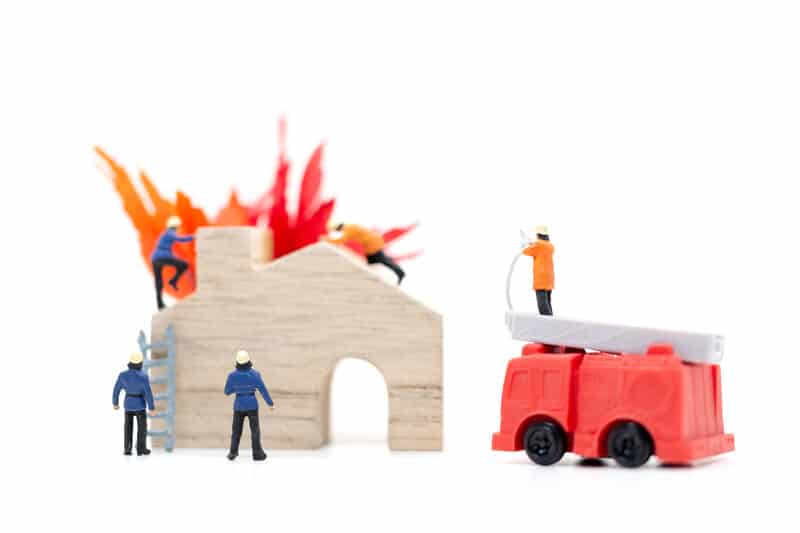 The past several years of fire seasons have taught Bay Area homeowners harsh lessons about the risks of wind-borne embers and firebrands, which are quick to ignite flammable materials from above rather than from direct flame contact. While it’s essential to observe county regulations about fire season preparation and clearance, California roofing contractors are dedicated to educating clients about the importance of fire-resistant roofing materials.
The past several years of fire seasons have taught Bay Area homeowners harsh lessons about the risks of wind-borne embers and firebrands, which are quick to ignite flammable materials from above rather than from direct flame contact. While it’s essential to observe county regulations about fire season preparation and clearance, California roofing contractors are dedicated to educating clients about the importance of fire-resistant roofing materials.
Consider Using Fire-Resistant Roofing Materials
If you’re preparing to repair or replace the roof on a residential or commercial building, ask prospective roofing contractors about fire-resistant roofing materials. These materials are either inherently or specifically designed to protect your home from fire, making them a smart investment in these unpredictable times.
Prioritize A Fire-Safe Landscape
Before we go through a list of fire-resistant materials for your roof, we want to remind you to take a whole-property approach to fire safety. This includes paying close attention to landscaping and pruning that resist fires and keep them from spreading to your home.
Read our post How to Prepare Your Roof for Fire Season and Natural Disasters for important points, such as:
- Contracting with a local arborist or tree expert to perform annual pruning and tree care around your home and property.
- Planting drought-resistant plants and maintaining their health
- Keeping the property free of dead, dry, or flammable debris
- Honoring county-wide fire clearance mandates year-round
- Scheduling routine roof and siding inspections and maintenance
The healthier your home features and landscape are the more resistant they are to fire.
Best Roofing Materials And Practices To Prevent Or Slow Down Fires
Wood and shake shingles are the most likely roofing materials to catch fire. If you have a wood or shake shingle home, we highly recommend replacing it with fire-resistant alternatives. However, even homeowners with non-wood or shake options may be at risk.
Only use class A roof coverings
Fire-resistant qualities of roofing materials are rated by an A, B, C, and Unrated systems, based on their performance during rigorous tests. Class A materials or methods are those that are the least combustible, least likely to allow a fire to spread across their surface, or too splinter and become shed as “firebrands.”
Class A roofing materials are the most fire-resistant when they’re installed correctly.
Common examples include Class A:
- Asphalt shingles
- Composite roof tiles
- Slate roof tiles
- Concrete tiles
- Metal roofs
Your roofing contractor should help you select the most reasonable, fire-safe roof covering option that aligns with your budget, home design, and commitment to fire safety. TAKE NOTE: Let your homeowner’s insurance know about your plans as they may offer certain premium discounts depending on your final selection and the completion of your new roof.
Beware of products with a “by assembly” fire rating
Some roofing materials are only rated as Class A when specific roof assembly protocols are followed. This is why it’s so important to work with a local, licensed, and experienced roofing contractor. Any contractor error could result in a roof that is more flammable – rather than fire-resistant.
Examples of roof coverings with a “by assembly” fire rating include aluminum, recycled plastic and rubber, and some fire-retardant wood shake products. If a wood shake roof does not have the manufacturer’s documentation specifying the fire retardant, assume it’s untreated
Roof coverings with gaps between the deck
According to firesafemarin.org:
Flat and barrel-shaped tiles, metal, and cement roof coverings can have gaps between the roof covering and sheathing, which typically occur at the ridge and edge of roofs. These openings can allow birds and rodents to build nests with materials that are easily ignited by embers. Flames from this type of ignited debris can spread to the structural support members, bypassing the protection offered by a Class A rated roof covering. Plugging these openings between the roof covering and the roof deck, is commonly called “bird stopping”. Regularly inspect and maintain these areas.
Routine roofing inspections should always be a priority, but that’s especially the case if you have or select a roof covering that has gaps between the covering and the sheathing.
Keep the roof free of debris
The most fire-resistant roofing materials and assembly can’t do their job if the roof is covered with dry/dead branches, twigs, leaves, dead moss/algae, or other flammable debris. Direct contact with significant flames will eventually catch your home or building on fire despite your conscientious efforts.
Any dead leaves or needles blown onto your roof by winds or storms create a flammable blanket, and even if the flames don’t catch roofing materials on fire, the flames can spread across the roof’s surface and wrap around dirty/filled gutters and the home’s siding, where it may catch fire.
Cover attic vents, roof and gable end vents, and under-eave areas
Fire science studies show that attic vents, roof and gable end vents, and under eave areas are vulnerable to embers and flames. In the right situations, embers and flames get into these small spaces and catch fire inside. Minimize entry points as much as you can without compromising the health of your whole-home structural systems. Then, cover any openings with durable, fire-rated wire mesh with openings no larger than 1/8-inches. This can help prevent airborne embers or firebrands from gaining entry.
20 Years Of Experienced Fire-Resistant Roof Installation
The team at Pacific Coast Roofing has two decades (and counting!) of experience installing fire-resistant roofs for Bay Area home and business owners. Contact us to schedule a free, no-obligation consultation and to learn more about how you can keep your home as fire-safe as possible.

